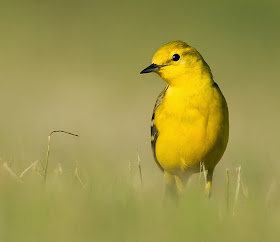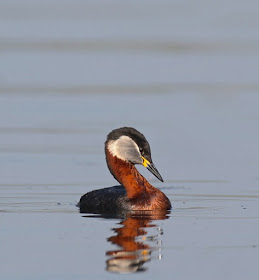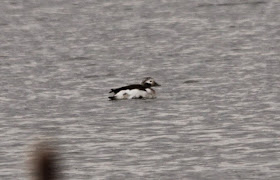 |
| courtesy of John Reynolds |
It's quite remarkable the sudden change in Oxon birding fortunes this
month. Of course with it now being April it is to be expected but still
it's quite a (pleasant) surprise. Whereas last month we were scratching
around for anything to report, this month if anything we've got too
much! So what were all these goodies?
Headline Birds
The star bird (or birds) of the month was the arrival of no less than four (3 drakes and a duck) Ring-necked Ducks which were found on the 4th at Pit 60 at Standlake. Normally this North American vagrant is found as a singleton so to have four on mainland Britain is something of national significance. It's also been a while since we've had this species in a properly twitchable form in the county so the lower orders of the county listing table were able to get their county tick. After the initial excitement, reports were less frequent but they seemed to find Pit 60 to their liking and at least 3 of them were still present on the 26th.
 |
| Male Ring-necked Duck courtesy of Steve Burch |
We also managed to get all four of the large more common Scarcities in the county this month, namely Crane, White Stork, Great White Egret and Spoonbill. Top of the list was the Cranes at Otmoor with a pair first seen on the 18th and then seen sporadically for a few days after that. Then a second pair turned up, heavily ringed and with radio transmitters - these were clearly from the Slimbridge release scheme. One pair was last seen on the 26th though it's not clear which of the two this was.
 |
| courtesy of Tezzer |
A Spoonbill was a great find for one lucky individual at the RSPB Otmoor reserve on the evening of the 10th though unfortunately it was only a fly-through.
 |
| Spoonbill courtesy of Carl Gray |
A probable Great Egret was seen briefly between Drayton & Sutton Courtenay at '1066' on the 13th and finally, to complete the set, a White Stork was reported Chinnor flew north from garden at 6:30am (per RBA)
The wintering Great Grey Shrike strayed across the border from Berks and was seen just west of Bury Down on the 5th so goes on the county list.
At the end of the month we had an intriguing report on RBA of a male Red-footed Falcon "reported" over Meadow Lane car park in Oxford at 7:45 pm before flying NE.
With such a great invasion of Hoopoes along the south coast and in particularly in the south west there was always going to be the possibility of one turning up in the county and this indeed did happen though sadly it was the all too usual case of it being found by a non birder in his garden (this time at Cholsey) and only being reported after it had moved on. A twitchable one would be most welcome for the lower orders in the county listing table.
.jpg) |
| Photo © courtesy of Giuseppe Morlando. |
Good County Birds
A Wood Warbler was a great discovery on the 16th near Harwell though sadly it was in an area of no general access so wasn't widely seen.
 |
| Wood Warbler courtesy of Stephen Collier |
The summer plumaged Red-necked Grebe which arrived last month remained at Farmoor reservoir until the 11th drawing admirers and photographers from far & wide.
 |
| Red-necked Grebe courtesy of Mark Chivers. |
The wintering female Long-tailed Duck was last reported from the Cassington GP complex on the 4th.
 |
| Long-tailed Duck courtesy of Mike Kosniowski |
A very splendid male Black Redstart was a surprise discovery in Kidlington on the 15th near to the Highway Man pub (formally The Wise Alderman) and amongst the units of the nearby Industrial estate. If that wasn't enough for what is normally a rather scarce county bird, there were also a pair at Harwell first thing on 24th.
 |
| Black Redstart by Badger |
April saw an unprecedented influx of Ring Ouzels in the home counties including Oxfordshire. The first two Rouzels appeared at the traditional site of Linky Down near Aston Rowant on the 11th with numbers gradually increasing to eleven by the evening of the 17th. Thereafter counts gradually declined though there were still 7 about on the 24th. Multiple birds were also reported at several sites on the Downs during the same period including Lollingdon Hill on the 17th and a male in Long Meadow Otmoor on the 13th.
 |
| Ring Ouzel courtesy of Mike Flemming. Part of a national influx. |
Finally to complete the Good County Birds section there was a Pied Flycatcher seen on the 21st in a private garden in Faringdon though sadly there was no general access available.
Raptors
A ringtail Hen Harrier was a one day wonder on Otmoor on the 10th and we can only guess at the perils this bird will face if returning to breed on the British uplands this year. A Hen Harrier also flew north over Aston Rowant on the 20th.
An Osprey wearing a satellite transmitter was seen over Chipping Norton on the afternoon of the 2nd
with a further two birds seen at Farmoor on the 4th and again on the 6th. Ospreys were seen near Wardington and at Blenheim also on the 6th and along the Thames at Sandford on the 12th.
 |
| Farmoor Osprey - Andy Last |
The long staying Marsh Harrier was joined by a second individual at the start of the month with a late Merlin also seen at the reserve on the 8th & 18th. Talking of late records, there was an unseasonal Short-eared Owl at Otmoor on the 21st near the Joseph Stone. Single Peregrines were reported at Otmoor on the 18th and Kingston Bagpuise 22nd. The Hobbies arrived back this month with a peak count of 7 at Otmoor on the 28th. There was also a single bird at Port Meadow on the 26th
 |
| Hobby - John Reynolds |
Wildfowl
The first Garganey of the year, a fine drake, showed up on the first day of the month at Stratfield Brake nature reserve on the outskirts of Kidlington. Four Garganey, including three drakes, also stayed on the Oxon/Bucks border at Mead Farm near Thame from the 5th-13th. A male and female Garganey graced the Tar Lakes near Stanton Harcourt from the 7th until at least the 11th. A further two females finally arrived on Otmoor on the 16th. A drake Garganey was on Port Meadow on the 8th being joined by a female the next day. There was also one reported at Dix Pit on the 18th and a drake was at the first screen at Otmoor from the 24th until the end of the month.
 |
| Drake Garganey Stratfield Brake courtesy of Tezzer |
Two Red-crested Pochards were seen throughout April at Farmoor and the adjacent Pinkhill Reserve with the count rising to 5 by the end of the month. There were also a pair at Dix Pit on the 18th. 18 of the feral Snow Geese flock were seen at Dix Pit 18th. Three Egyptian Geese turned up at Port Meadow on the 22nd, where they stayed until the month's end, being joined by 2 more for the last couple of days.
Gulls & Terns
Severn Little Gulls stopped off at Farmoor reservoir on the 9th with the number rising to 13 by the the next day, three Little Gulls were also seen over Kingston Bagpuize on the 11th with five over on the 16th. Farmoor peaked with 25 on the 21st and then had one or two until the end of the month. Otmoor managed to contribute 1 on the 20th.
 |
| Little Gull courtesy of The Gun-slinger |
 |
| Little Gull - Roger Wyatt |
A Black Tern was at Farmoor reservoir on the 10th with two birds present on the 17th and one on the 23rd. Away from the reservoir there was 1 at Otmoor on the 22nd.
 |
| Black Tern - Roger Wyatt |
There were a few Arctic Terns from the middle of the month onwards at Farmoor with the peak passage occurring on the 21st with a whopping flock of 70 birds. Sonning Eye GP had a singleton on the 26th.
 |
| Arctic Tern - Roger Wyatt |
Two Mediterranean Gulls were seen over Port Meadow on the 12th with two more birds seen on Otmoor on the 16th.
Waders
There were still Jack Snipe in the county in April with at least three birds recorded at Otmoor on the 1st. A Black-tailed Godwit was on Otmoor on the 6th with five birds on Port Meadow from the 5th with this number rising to eight birds by the 16th. Otmoor hosted 3 birds from the 18th until at least the 22nd. It's rarer cousin within Oxon, the Bar-tailed Godwit was seen at Pit 60 with 2 birds on the 22nd and 1 on the 26th.
The first Ruff of the year turned up at the RSPB reserve on Otmoor on the 7th with five birds present on the 9th and a variable number staying through until the end of the month. Balscote Quarry contributed 5 on the 18th. Little-ringed Plovers and Ringed Plover were present in small numbers during the month at at the usual county sites. Sanderling were seen on Big Otmoor on the 11th on the 11th with a second Sanderling on Port Meadow on the 12th and 2 at Farmoor on the 26th.
 |
| Sanderling courtesy of Gnome |
Greenshank were on Otmoor on the 12th and at Rushy Common on the 13th. Otmoor and Farmoor then hosted between 2 and 3 birds on and off for the rest of the month. A Grey Plover was seen briefly at Otmoor on the 23rd. A Turnstone was feeding along the Farmoor causeway on the 15th with 3 at the same site on the 26th.
 |
| Greenshank - Roger Wyatt |
A flock of 20 Whimbrel flew in to Port Meadow on the 22nd though 18 of them left and were later seen flying over Pit 60. Otmoor and Farmoor hosted between 1 and 3 birds sporadically towards the end of the month.
A fly-over Green Sandpiper was seen at Otmoor on the 20th, with 1 at Pit 60 on the 26th and 1 at Rushey Common on the 28th. Common Sandpipers started coming through this month peaking with a
count of 17 at Farmoor on the 26th with 11 still present by the end of
the month.
Passerines
The first Cuckoo of the year was seen near Duns Tew on the 10th with the next at Farnborough on the 13th. After that birds were reported in small numbers throughout the county. A White Wagtail was seen near Wheatley on the 2nd with a single at Grimsbury & Farmoor Reservoir on the 12th
Five Hawfinch were recorded in the Blenheim Palace garden on the 3rd with constituting the only county record this year.
The first Redstarts started to appear from the 9th with a fine male in Burgess Field Port Meadow with a second and third Redstart recorded at Wychwood on the 14th and Otmoor on the 15th. Further individuals were found at Barford St.Michael on the 15th and at Linky Down on the 16th.
There was a good smattering of Whinchat records throughout the county with Otmoor providing the bulk of them and peaking at 6 on the 29th. This years first reeling Grasshopper Warbler was heard amongst the rushes on Otmoor on the 14th. Two Firecrests were found and heard singing at undisclosed location near Abingdon. A Spotted Flycatcher was reported at Garsington on the 26th
Pochard Travels
This
Pochard (see below) was in front of the second screen on Otmoor on the 6th of April
and was wearing a blue nasal saddle. It was last seen near
Saint-Philbert-de-Grand-Lieu in France last November.
Moving On
Congratulations to Joe Harris on his new post as site manager at the RSPB Langford Lowfields reserve near Nottingham. Joe has been fundamental in the development of the Otmoor nature reserve over the last four years and has even found time to find a few good birds on the reserve. He will be leaving at the end of May and I'm sure we speak for all of the Otmoor regulars and visitors alike in wishing Joe good luck.
 |
| Joe Harris |
The King of the Lakes
by Keith Clack
During 2004 extensive travelling in the company of my usual birding chums, enabled me to see a superb list of extremely rare birds. Among them a Blyth's Pipit at Land's End, Cream Coloured Courser on Scillies, Sora Rail in Nottinghamshire, American Golden Plover in Essex, Western Sandpiper on Brownsea Island, Greenish Warbler in Norfolk and topping things off, Britain's first ever Masked Shrike in Fife. However for sheer majesty, my first Golden Eagle was the highlight of that year.
Around this time there had been a pair of eagles in the Lake District, near Haweswater, but unfortunately the elderly female had gone missing leaving a very frustrated much younger male in residence- the only Golden Eagle in England. I had booked Shirley and myself into the Haweswater Hotel which overlooked the lake that now filled the valley and it was from there we set off early next morning heading for the limited parking at the end of the road at the far end of the lake.
From the moment we left the car the scenery was magnificent with legendary climbs such as High Street soaring away in front while in the lake alongside our path, the blue sky and white clouds provided a mirror image, as if one wasn't enough. We trudged ever upwards, slowly, through resin scented stands of trees, to the lip of the valley, only to appear at the bottom end of another. This valley was classic upland terrain, rugged with few bushes but many flowers in the lower parts and a rapid flowing, musical stream that flowed hurriedly down the slopes. Alongside this at the valley head, was a small wooden hut, the summer home of the RSPB warden who watched over the well being of the eagle(s), stopping careless fell walkers and climbers from straying too close to the bird(s).
Along the stream we soon found Dipper and Grey Wagtail and from the scree above came the loud and desolate song of a male Ring Ouzel, one of two we found high above us. Above all of these there perched the biggest, most impressive bird I had ever seen. Shirley was taken aback at the sheer majesty of this creature which for over 2 hours we watched preening, stretching, defecating and snoozing on it's rocky throne, monarch of all it surveyed. Although distant, every detail could be clearly seen in the clear, crisp air and we were happy just to watch it lording over all beneath it.
Reluctantly we left it, hoping to find Red Squirrels in a wood at the other end of Haweswater Valley and in failing in this we were nonetheless rewarding with great views of a male Pied Flycatcher doing exactly what it says on the can! As of 2014, the Golden Eagle still performs in it's lonely valley, hoping to attract a passing female drifting down from Scotland- I do hope one loses her way and finds him good company.





No comments:
Post a Comment